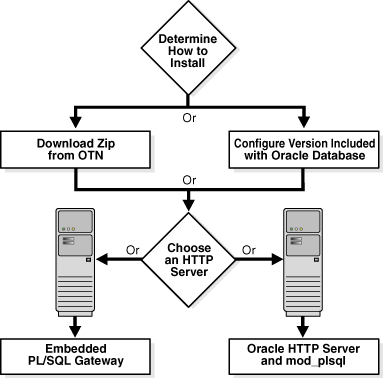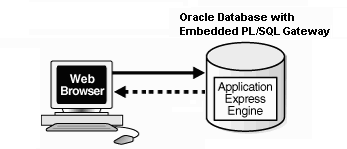| Oracle® Application Express Installation Guide Release 3.2 Part Number E12196-03 |
|
|
PDF · Mobi · ePub |
| Oracle® Application Express Installation Guide Release 3.2 Part Number E12196-03 |
|
|
PDF · Mobi · ePub |
This chapter provides an overview of installing Oracle Application Express and describes issues to consider before installing.
This chapter contains these topics:
The installation process consists of four parts:
Plan your installation: This chapter offers an overview of the steps required to install Oracle Application Express. During the planning phase, you should also determine whether to install a full development environment or runtime environment.
A full development environment provides complete access to the Application Builder environment to develop applications. A runtime environment is an appropriate choice for production implementations in which you want to run applications that cannot be modified. To learn more, see "About the Oracle Application Express Runtime Environment".
Verify installation requirements: "Oracle Application Express Installation Requirements" describes the minimum requirements that your system must meet before you install the software.
Install the software: As described in Figure 1-1, the required installation steps depend upon:
How you install the Oracle Application Express. Available options include downloading a ZIP file from Oracle Technology Network (OTN), or using the version of Oracle Application Express that installs with Oracle Database 11g or later.
Which HTTP server you decide to use. Available options include the embedded PL/SQL gateway or Oracle HTTP Server and mod_plsql.
To learn more, see "About Choosing an HTTP Server".
Figure 1-1 Key Decision Points in the Installation Process

If you have version 1.5.0.00.33, 1.5.1.00.12, 1.6.0.00.87, 1.6.1.00.03, 2.0.0.00.49, 2.2.1.00.04, 3.0.0.00.20, 3.0.1.00.07, 3.0.1.00.08, 3.0.1.00.12, 3.1.0.00.32, 3.1.1.00.09 or 3.1.2.00.02 of Oracle Application Express, following any of the installation scenarios in this guide upgrades your Oracle Application Express instance to version 3.2 and creates Oracle Application Express 3.2 database objects in a new schema and migrates the application metadata to the new version.
For testing and production instances, Oracle Application Express supports the ability to install just a runtime version of Oracle Application Express. This runtime environment minimizes the installed footprint and privileges and improves application security since in a runtime instance developers cannot advertently update a production application.
An Oracle Application Express runtime environment enables you to run production applications, but it does not provide a Web interface for administration. A runtime environment only includes the packages necessary to run your application, making it a more hardened environment. You administer the Oracle Application Express runtime environment using SQL*Plus or SQL Developer and the APEX_INSTANCE_ADMIN API. To learn more see, "Managing a Runtime Environment" in Oracle Application Express Application Builder User's Guide.
Scripts are provided to remove or add the developer interface from an existing instance. To learn more, see "About the Oracle Application Express Runtime Environment" in "Downloading from Oracle Technology Network" and "Configuration Tasks When Installing from the Database".
In order to run, Oracle Application Express must have access to either Oracle HTTP Server and mod_plsql or the embedded PL/SQL gateway.
Topics in this section include:
Oracle HTTP Server uses the mod_plsql plug-in to communicate with the Oracle Application Express engine within the Oracle database. It functions as communication broker between the Web server and the Oracle Application Express objects in the Oracle database. More specifically, it maps browser requests into database stored procedure calls over a SQL*Net connection. The following graphic illustrates the Oracle Application Express architecture using Oracle HTTP Server and mod_plsql.

See Also:
"HTTP Server Requirements"Note that this three tier architecture consists of the following components: a Web browser, Oracle HTTP Server (Apache) with mod_plsql, and an Oracle database containing Oracle Application Express.
Advantages of Oracle HTTP Server (Apache) with mod_plsql:
Separation of mid-tier for the database tier
Appropriate for Oracle Real Application Clusters (Oracle RAC) environments
In an Oracle HTTP Server or Oracle Application Server configuration, images are stored on the file system in the location referenced by the alias /i/. If you are upgrading Oracle Application Express from a prior release, you can locate the images directory on the file system, by reviewing the following files and searching for the text alias /i/:
Oracle9i HTTP Server Release 2—see the httpd.conf file.
Oracle HTTP Server distributed with Oracle Database 11g—see the dads.conf file.
Oracle Application Server 10g—see the marvel.conf file.
Specific examples for locating the text alias /i/ can be found in "Downloading from Oracle Technology Network" and "Configuration Tasks When Installing from the Database".
The embedded PL/SQL gateway installs with Oracle Database 11g. It provides the Oracle database with a Web server and also the necessary infrastructure to create dynamic applications. The embedded PL/SQL gateway runs in the Oracle XML DB HTTP server in the Oracle database and includes the core features of mod_plsql. The following graphic illustrates the Oracle Application Express architecture using the embedded PL/SQL gateway.

As shown in the previous graphic, the embedded PL/SQL gateway is a simple two tier architecture and consists of theses components: a Web browser and an Oracle database, containing the embedded PL/SQL and Oracle Application Express.
Advantages of the embedded PL/SQL gateway:
Ease of configuration
Included in the database
No separate server installation
The embedded PL/SQL gateway runs in the database as part of the XML DB HTTP Protocol Listener. The XML DB HTTP Protocol Listener and embedded PL/SQL gateway provides the equivalent core features of Oracle HTTP Server and mod_plsql. Because the HTTP Listener runs in the same database where Oracle Application Express is installed, it is not possible to separate the HTTP listener from the database. For this reason, it is not recommended to use the embedded PL/SQL gateway for applications that run on the Internet. Additionally, the embedded PL/SQL gateway does not provide the same flexibility of configuration and detailed logging as Oracle HTTP Server with mod_plsql.
When running Oracle Application Express with the embedded PL/SQL gateway, images are stored directly in the database within the Oracle XML DB repository. You can access images by using the WebDAV feature of Oracle XML DB or by using FTP. To learn more, see "Using Protocols to Access the Repository" in Oracle XML DB Developer's Guide.
When running Oracle Application Express in an Oracle Real Application Clusters (Oracle RAC) environment, Oracle recommends that you use Oracle HTTP Server with mod_plsql. Oracle HTTP Server with mod_plsql permits you to specify a connection in the service name format, so that one HTTP Server can access all nodes.
Oracle recommends that you do not select the embedded PL/SQL gateway option for Oracle RAC installations. The embedded PL/SQL gateway uses an HTTP Server built into the database instance, and because of this, it does not take advantage of the Oracle RAC shared architecture.
How you install Oracle Application Express depends upon where you install the software from and which HTTP server you decide to use. This section provides an overview of each installation scenario.
See Also:
"About Choosing an HTTP Server" and "About the Oracle Application Express Runtime Environment"Topics in this section include:
Scenario 1: Downloading from OTN and Configuring the Embedded PL/SQL Gateway
Scenario 2: Downloading from OTN and Configuring Oracle HTTP Server
Scenario 3: Installing from the Database and Configure the Embedded PL/SQL Gateway
Follow the steps in this scenario if you are downloading Oracle Application Express from Oracle Technology Network (OTN) and configuring the embedded PL/SQL gateway. Required installation steps in this scenario include:
Follow the steps in this scenario if you are downloading Oracle Application Express from Oracle Technology Network (OTN) and configuring Oracle HTTP Server with mod_plsql distributed with Oracle Database 11g or Oracle Application Server 10g. Required steps in this scenario include:
Step 1: Install the Oracle Database and Complete Pre-installation Tasks
Step 4: Restart Processes
Step 5: Configure Oracle HTTP Server Distributed with Oracle Database 11g or Oracle Application Server 10g
Step 7: Security Considerations
Step 8: About Running Oracle Application Express in Other Languages
Step 11: Create a Workspace and Add Oracle Application Express Users
Follow the steps in this scenario if you are using a version of Oracle Application Express that installs with Oracle Database 11g or later and configuring the embedded PL/SQL gateway. Required steps in this scenario include:
Follow the steps in this scenario if you are using a version of Oracle Application Express that installs with Oracle Database 11g or later and configuring Oracle HTTP Server with mod_plsql distributed with Oracle Database 11g or Oracle Application Server 10g. Required steps in this scenario include:
Step 1: Install the Oracle Database and Complete Pre-installation Tasks
Step 2: Configure Oracle HTTP Server Distributed with Oracle Database 11g or Oracle Application Server 10g
Step 4: Security Considerations
Step 5: About Running Oracle Application Express in Other Languages
Step 8: Create a Workspace and Add Oracle Application Express Users